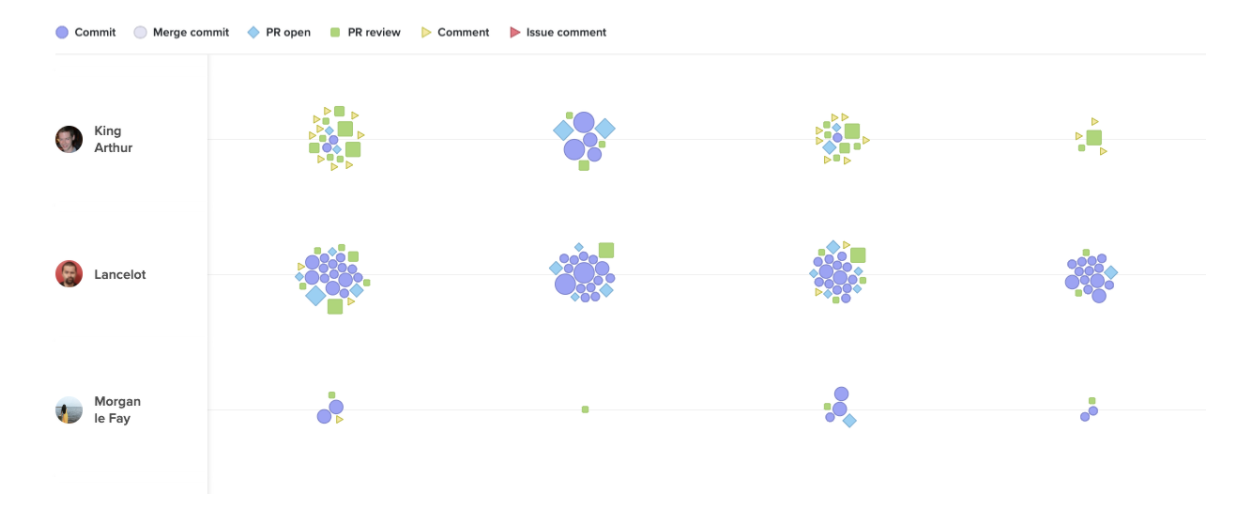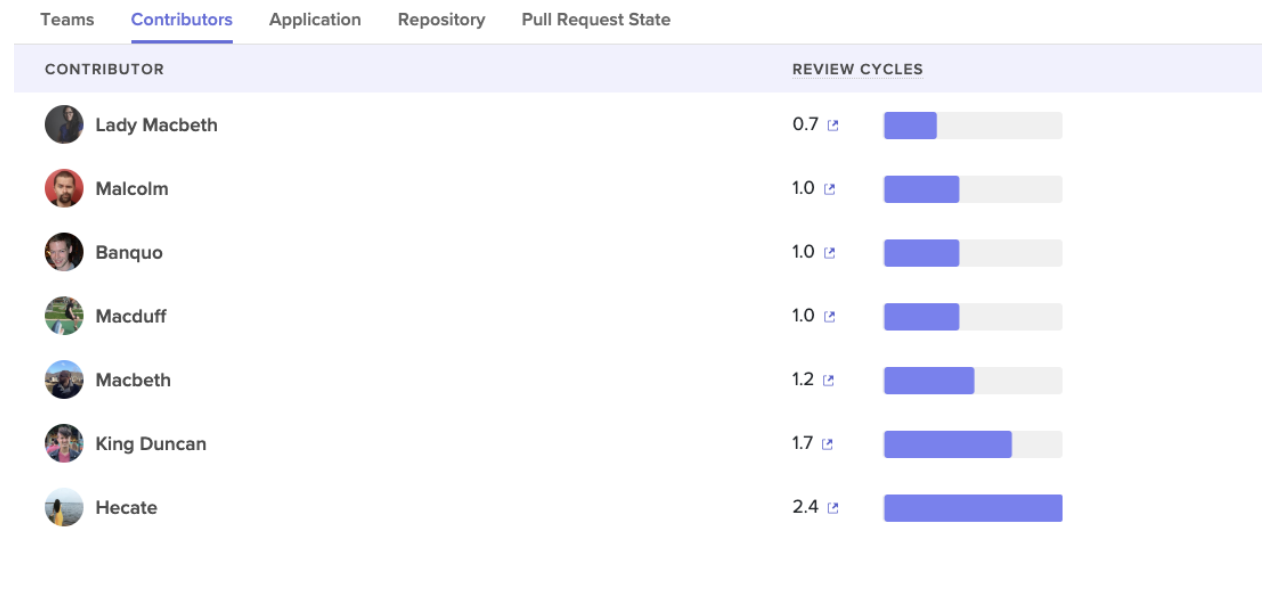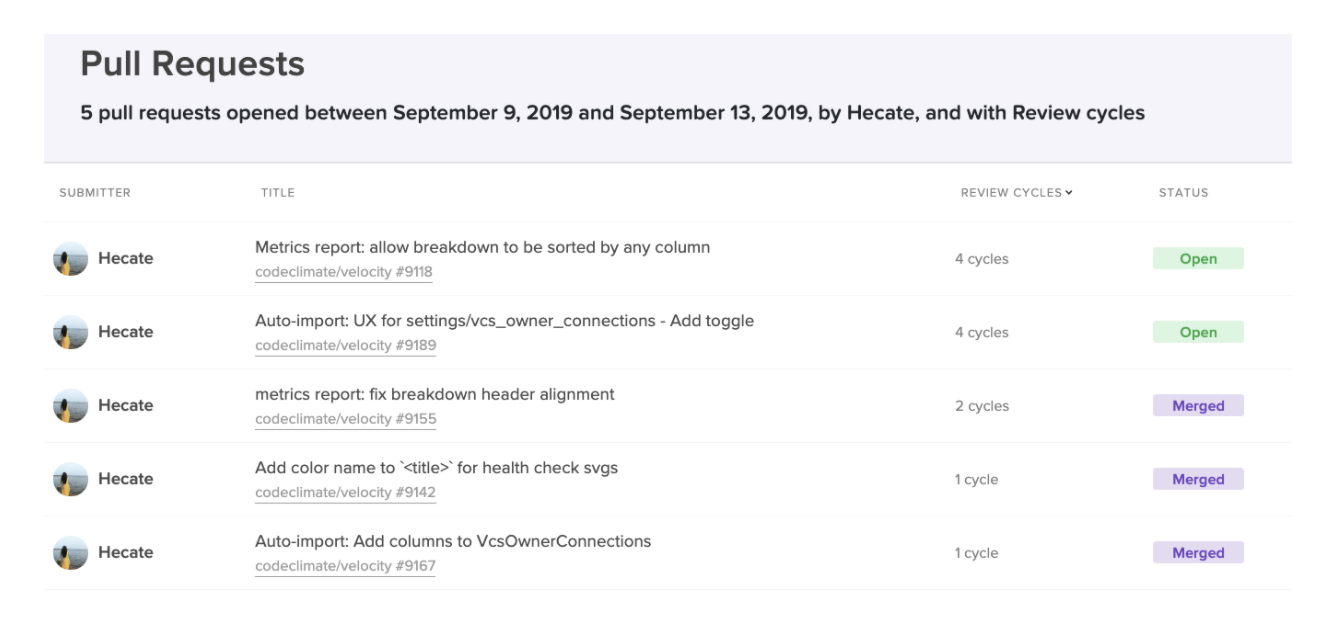The more engineers on your team, the harder it is to gain visibility. If you’re managing four people or more, you’re probably asking questions like:
- How do I supervise the work of all of these engineers?
- How do I make sure I’m adding value where needed?
You can leverage Velocity to address both of these concerns.
Get Immediate Visibility into Your Engineers’ Work
A quick scan of the Activity tab in the Team360 report will give you a sense of both what your team is working on right now and their general work habits.
Hover over a purple circle to see your team’s commits and understand what they’re working on without having to tap them on the shoulder.

Look for:
- Developers who haven’t committed code for a few days. They might be bottlenecked, especially if they’re new to the team.
- Developers whose commits don’t match your expectations for what the team is working on.
- Big commits and PRs (visualized by the largest shapes on the graph).
- Work that is distributed in a way that doesn’t match your expectations.
Use this concrete data as a jumping-off point for in-depth conversations with your team.
Identify High-Risk Pull Requests
Use the Pull Requests report to see PRs that may warrant your attention.
Most managers start by looking for open, high activity PRs. Activity is defined as PRs that are getting either a lot of commits or a lot of comments. To surface the oldest PRs, sort by age by clicking on the "Age" column within Pull Requests. Pay close attention to anything that’s been open for over 72 hours.

You might want to talk to someone like Harry Potter to see if there’s anything you can do to unblock him.
Understand Which Developers Might Need Help
There are a number of metrics that can help you find stuck engineers:
- Weekly Coding Days represents engineering capacity, or how much time per week developers are able to spend actually coding. When this metric dips, it’s an indicator that a team member might be (1) working in large chunks or (2) stuck on a feature or bug.
- PR Throughput & PRs Reviewed are output metrics. If these look unexpectedly low, it might be worth a quick conversation to understand what’s going on.
- Review Cycles & Rework are both proxies for churn. Review Cycles represent the number of times a Pull Request has gone back and forth between the author and reviewer. Rework is the percentage of lines of code that have been rewritten by the same developer within 3 weeks and is helpful for identifying churn earlier on in the development cycle.
Compare these metrics by team or by person in the Compare report to identify who is stuck.

Dive Deeper into Churn Metrics
High Review Cycles and high Rework represent waste in the development process and are therefore a great place to start optimizing.
A developer with high Review Cycles has been asked to go back and fix things in their PRs multiple times. If you see someone with higher than expected Review Cycles, you can investigate further by going into the Analytics tab.
Run a query for Review Cycles, grouped by contributor over the last week or two. Scroll to the bottom until you see the following bar graph visualization:

To understand what’s blocking specific engineers, like Hecate, you can click the arrow next to her Review Cycle count to drill down into specific PRs.

Sort the number of Review Cycles from high to low and look through the ones that have been open the longest. Anything above 1.5 Review Cycles may indicate a problem. In this case, the top two open PRs with 4 Review Cycles is a good place to start.
You can run this same process for Rework, which is another indicator of churn, but at the coding level. Note that the top quartile of engineering organizations keep their Rework to less than 4%.
Use Metrics to Enhance Visibility
Though metrics can’t tell managers everything they need to know, they can be a valuable tool for gaining insight into the work that’s happening on your team. With data like that found in Velocity, you can spot stuck work before it becomes a bottleneck, and make sure your team’s processes are effective.
If you’re not already using Velocity, speak to one of our specialists and find out how you can get a more complete picture of the work being done on your team.
Get articles like this in your inbox.
Trending from Code Climate
1.
Engineering Leaders Share Thoughts on Leadership in Disrupted Times in a New Survey
For engineering teams, disruption to the business can have a significant impact on the ability to deliver and meet goals. These disruptions are often a result of reprioritization and budget changes on an organizational level, and are amplified during times of transition or economic instability.

2.
Built In’s 2023 Best Places to Work — Why Code Climate Made the List
At Code Climate, we value collaboration and growth, and strive for greatness within our product and workplace. For us, this means fostering a supportive, challenging, people-first culture. Thanks to an emphasis on these values, we’ve earned spots on three of Built In’s 2023 Best Places to Work awards lists, including New York City Best Startups to Work For, New York City Best Places to Work, and U.S. Best Startups to Work For.

3.
Turnkey Deployment Delivers Day-One Value for Yottaa
Learn how Yottaa gained immediate value from Code Climate Velocity right out of the box.

Get articles like this in your inbox.
Get more articles just like these delivered straight to your inbox
Stay up to date on the latest insights for data-driven engineering leaders.

